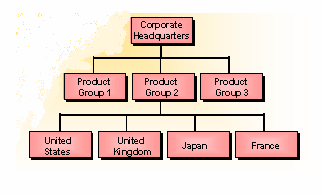Global Division Structure or International Division Structure of an Multinational Enterprise involves vesting the responsibility for total management of global business activities with one designated division or department called Global Division. Globally specialized personnel are placed in charge of the division to handle the diverse matters as export/import negotiations, export/import documentation, foreign-exchange transactions, relations with foreign governments, foreign subsidiaries personnel management, foreign market promotion, etc. Most MNCs in their initial stages of globalization employed the ‘Global Division Structure’ covering certain regions of the world to supervise the functions in those regions. But conflicts could arise between the functional heads and the heads of the global division. Following figure gives a simple model of Global Division Structure.
Randall S. Schuler, Peter J. Dowling, Helen De Cieri in their research paper in Journal of Management, Summer, 1993, observed that in the case of the Global division structure (design) the MNE basically adds on a unit to deal with global business concerns. The original organization structure is left intact. The global division becomes a unit that mirrors the domestic businesses of the MNE abroad. The key business decisions are made at the global headquarters, typically also the headquarters of the MNE. Knowledge is also developed at the center and dispersed where needed.
Issues in Global Division Structure
Is the structure globally competitive, efficient, responsive and flexible to local needs and conditions? As the level of operation is minimal, the question of global competitiveness is too big to address. The structure is efficient as the headquarters is in full grip of the functioning of the affiliates. Responsiveness and flexibility to local needs and conditions may be only minimally facilitated in this type of operation, but local commitments are also minimal. Consequently, global human resource decisions may be primarily associated with selecting the head of global operation and then the expatriate who may be sent abroad to operate the global location. Of course more human resource issues do arise for the expatriate in charge of this location, but they tend to be modest compared with similar issues faced by MNEs selecting a global form of organization.
Merits of Global Division Structure
Global Division Structure prevents duplication of efforts in more than one place in the organization in the discharge of activities regarding foreign affiliates. Besides, when foreign business is not of big scale, this organizational form creates a large enough critical mass of activities so that personnel within the division can wield power within the organization to push for global expansion. In the initial stages of foreign exposure this form gives the MNE an opportunity for strategic focus through concerted close-line management involving dedicated efficient personnel.
Demerits of Global Division Structure
The global division has to depend on other domestic divisions of the parent for products/services, personnel, technology, and other resources for the promotion of the foreign activities. The domestic division managers may not cooperate with the global division personnel due to sheer egoism or due to the fact that they are usually not evaluated on the basis of performance of the foreign activities but only on the basis of achievements of their domestic divisions. Hence they may withhold their best resources from the global division to improve their own performances.
Suitability of Global Division Structure
This structure is probably best suited for multi-domestic strategies, where there is little integration and standardization between domestic and foreign operations. That is the global division is independent of domestic divisions in most decision areas. Global Division Structure is popular among U.S. MNEs, but not with the European MNEs. The reason is not due to cultural differences between USA and Europe. USA has a vast domestic market, reducing the size of foreign market for most MNEs, not warranting functional or product specializations. Hence the all-in-one global division is suffice. In the case of Europe any single European nation offers only a small domestic market. With big foreign market, the all-in-one global division is not the best form. With the EU common market with the common currency Euro, the scenario may change.
